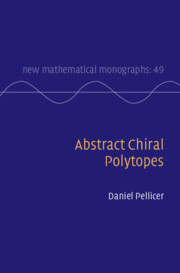Refine search
Actions for selected content:
2 results
3 - Groups Related to Chiral Polytopes
-
- Book:
- Abstract Chiral Polytopes
- Published online:
- 23 March 2025
- Print publication:
- 03 April 2025, pp 101-207
-
- Chapter
- Export citation

Abstract Chiral Polytopes
-
- Published online:
- 23 March 2025
- Print publication:
- 03 April 2025
